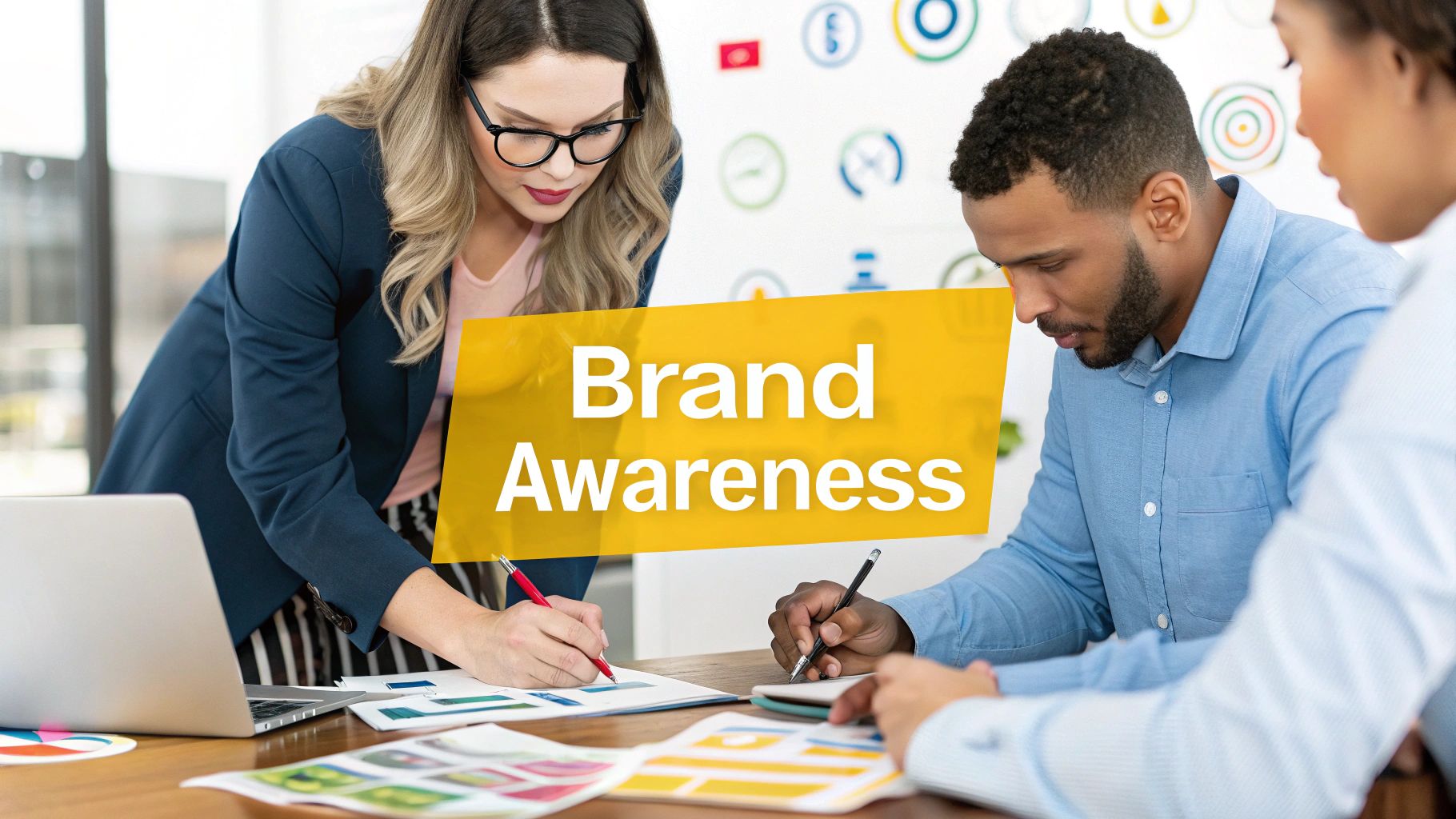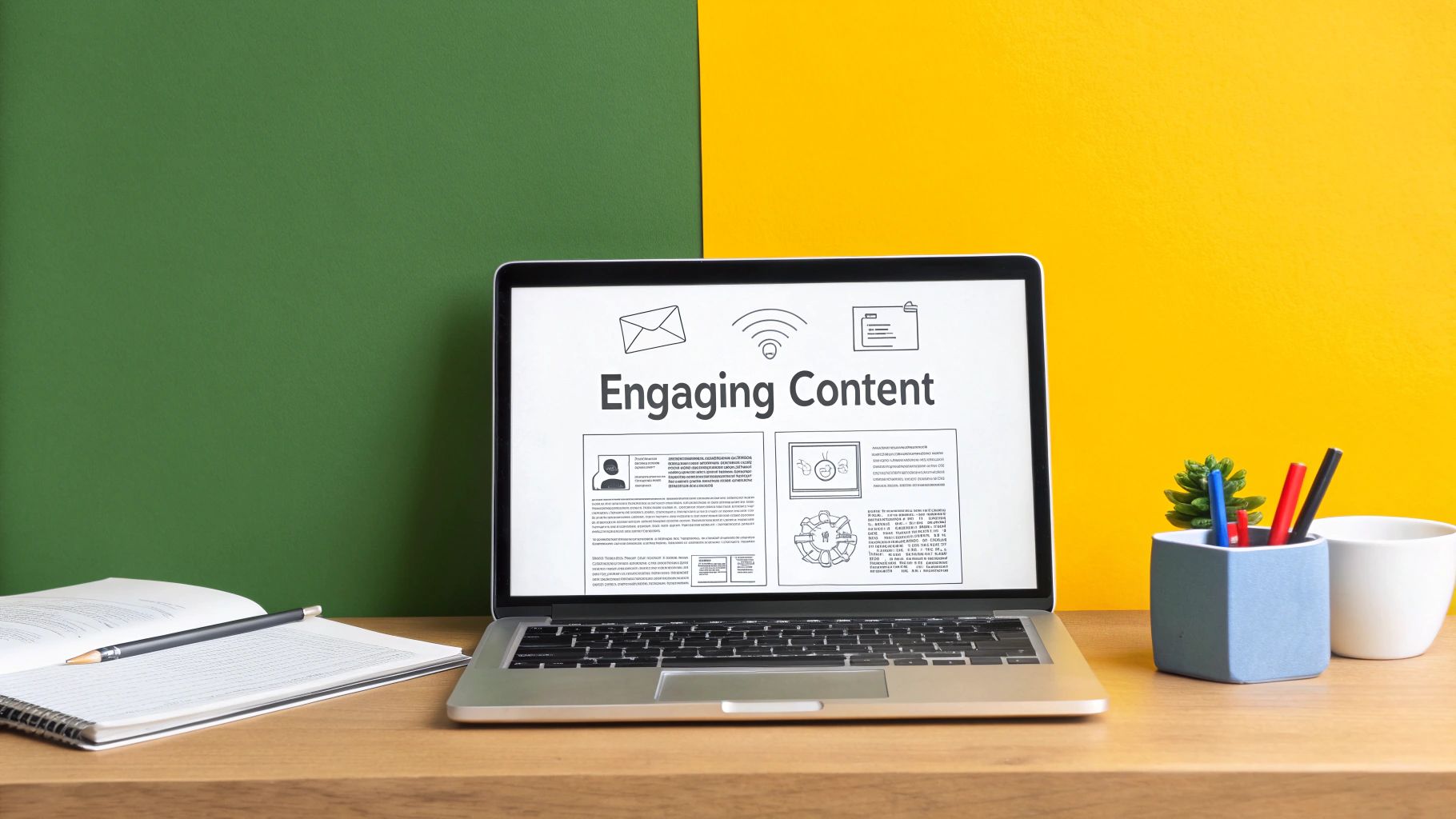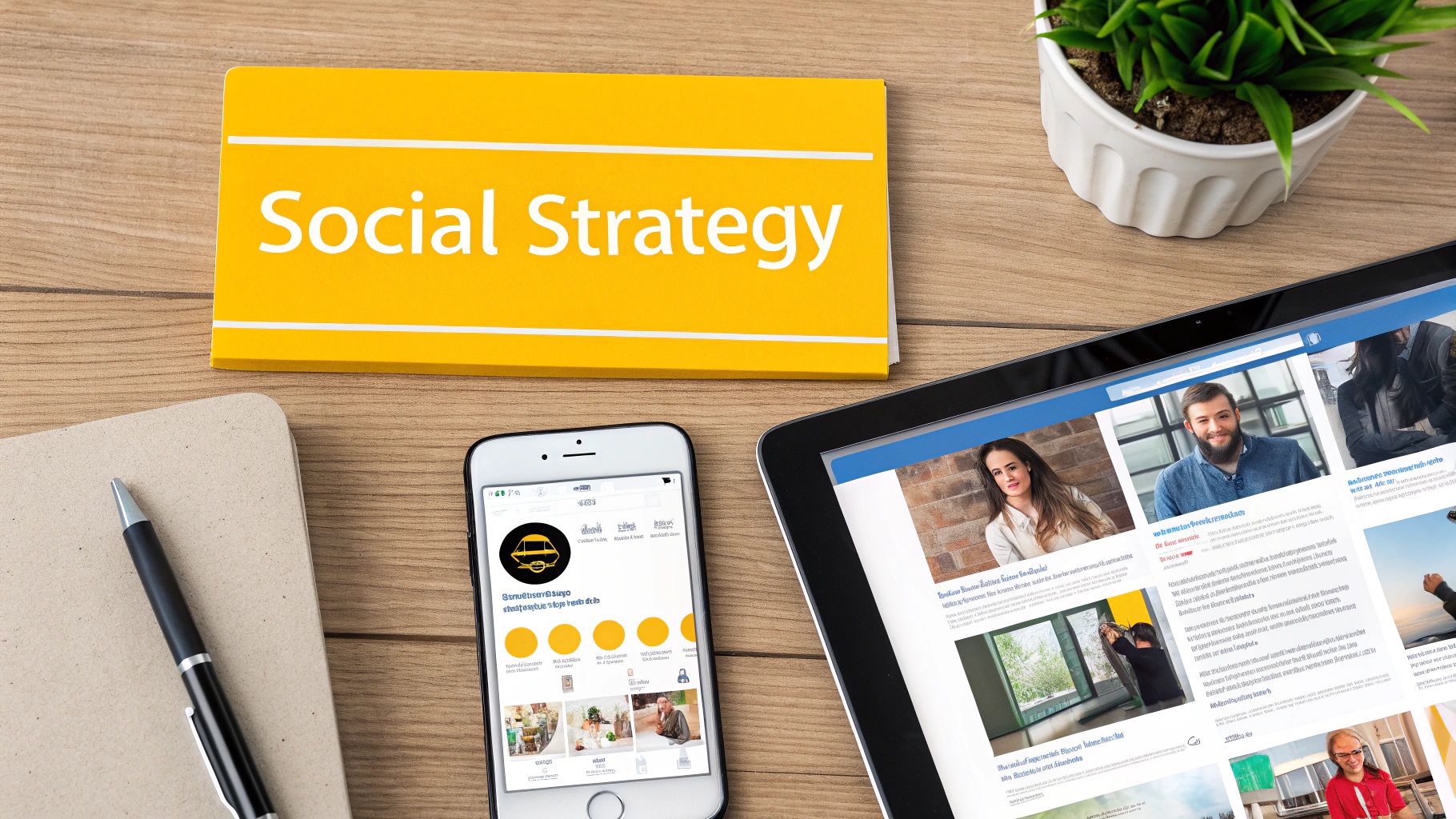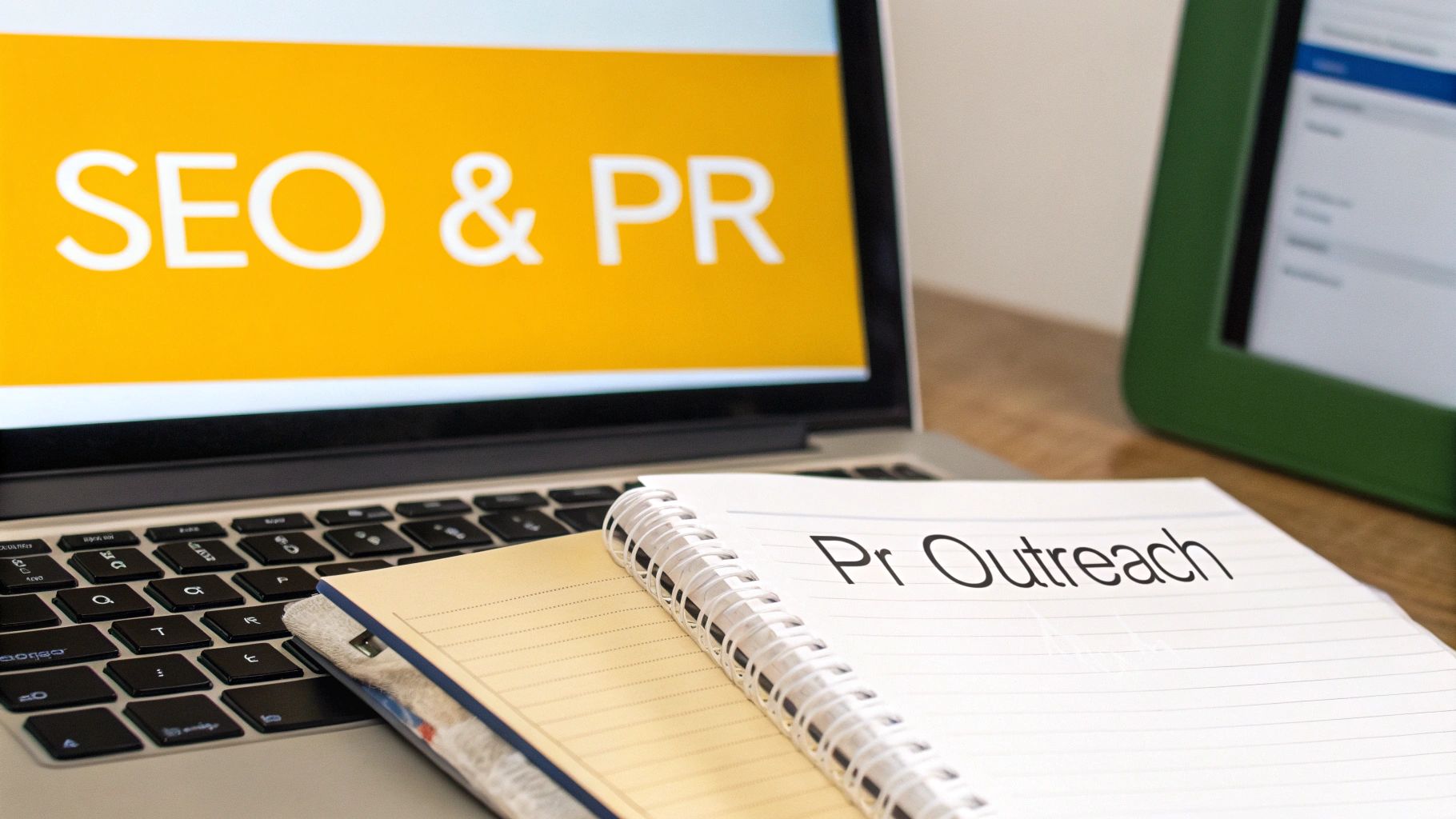How to Build Brand Awareness: Effective Strategies to Grow Your Brand

Before you can get your brand noticed, you have to get to know it yourself. This means digging deep into your brand's core identity—its unique value, personality, and visual style. It's about crafting a consistent, memorable experience that connects with your audience long before you ever spend a dime on ads or social media.
This foundation is what makes every interaction, every piece of content, and every customer touchpoint reinforce who you are.
Building a Brand People Actually Remember

It’s tempting to jump straight into marketing tactics. So many businesses do. They start chasing visibility without first building a solid identity. But when people finally do look their way, what they see is often inconsistent, confusing, and ultimately forgettable.
Think of it like building a house without a blueprint. The end result is a chaotic mess.
Real brand awareness isn't just about getting people to recognize your logo. It's about them getting what you stand for, understanding what makes you different, and feeling a reason to care. That all starts with defining your core message and identity.
Define Your Unique Value Proposition
Your Unique Value Proposition (UVP) is the absolute cornerstone of your brand. It’s a simple, clear statement that answers three questions: what benefit do you offer, how do you solve your customer's problems, and what makes you different from everyone else? Don't just list features. Focus on the single most compelling promise you can make.
For instance, a generic software company might say, "We sell project management software." That's a feature. A company with a strong UVP, on the other hand, would say, "We help remote teams finish projects on time, without the chaos." See the difference? The second one immediately hits on a specific benefit for a clear audience.
To nail down your UVP, ask yourself these questions:
- What specific problem do we solve better than anyone else in the market?
- What are the tangible results customers get from working with us?
- Why should our ideal customer choose us over a competitor they're already considering?
Craft a Consistent Voice and Visuals
Once you know what you stand for, you need to decide how you're going to say it. This is where your brand personality comes to life. It’s about creating a consistent voice and visual style that shows up everywhere, from your website copy to your social media replies.
Is your brand witty and informal? Or is it more authoritative and professional? Whatever you choose, it needs to feel authentic to who you are and connect with the people you’re trying to reach.
This consistency is what builds trust, and trust is everything. In fact, 81% of consumers say they need to trust a brand before they'll even consider buying from it. That number shows just how critical a reliable brand image really is.
A brand is no longer what we tell the consumer it is—it is what consumers tell each other it is. Your job is to give them a great story to tell by being consistent in every interaction.
The only way to maintain this consistency is to document it. Everyone on your team needs to be on the same page. If you're ready to get this formalized, our guide on https://getnerdify.com/blog/how-to-create-brand-guidelines is the perfect place to start. For a deeper dive into practical approaches for increasing visibility and building a memorable brand, explore these 9 B2B Brand Awareness Strategies.
Creating Content That Connects and Captivates

Once you've nailed down your brand's identity, it’s time to start creating content that actually gives people a reason to pay attention. This isn't just about filling a quota of blog posts or social media updates. It’s about building a library of genuinely useful assets that solve real problems, answer tough questions, and maybe even entertain your audience.
Great content is what powers brand awareness. It’s how you prove you know your stuff, let your brand’s personality shine, and start building a real relationship with people long before they’re ready to buy anything. Your goal is to become their go-to resource, not just another company trying to sell them something.
Identify and Fill Content Gaps
One of the smartest ways to get noticed is to find the gaps your competitors are missing. Take a hard look at the content that’s already out there in your niche. What questions are people constantly asking that nobody is answering well? What topics are only getting a surface-level treatment when you could go so much deeper?
This is where you can make your mark. Forget another generic "Top 5 Tips" post. Instead, create the definitive guide on a topic that everyone will want to bookmark and share.
And don't just stick to writing. Think about other formats where you could really stand out:
- Shareable Infographics: Can you break down a complex process or some dense data into a visual that’s easy to digest?
- A Niche Podcast: What if you interviewed experts or even your own customers to share stories and insights no one else has?
- In-Depth Video Tutorials: Show people exactly how to solve a problem they’re struggling with. Sometimes showing is far more powerful than telling.
When you take this approach, you position your brand as the expert. People will start associating your name with quality, helpful information, which is a huge win for awareness. To really make your brand stick, tap into the power of narrative—these brand storytelling examples are a great source of inspiration.
Build a Content Calendar That Delivers Value
If you're only posting sporadically, you’ll never build the momentum you need. Consistency is everything. That’s why a content calendar isn’t just a nice-to-have; it's a non-negotiable tool for anyone serious about brand awareness. Think of it less as a schedule and more as a strategic roadmap for delivering consistent value.
A good calendar maps out your themes and topics weeks, or even months, in advance. This saves you from the last-minute scramble for ideas and helps you weave a cohesive story around your brand’s core message over time.
The best content doesn't feel like marketing. It feels like a gift. It solves a problem, offers a new perspective, or provides a moment of entertainment, all while subtly reinforcing what your brand stands for.
Before you create anything, always ask yourself: "What's in it for them?" Every single piece of content should have a clear purpose, whether that’s to educate, inspire, or entertain. This audience-first mentality is what separates content that connects from content that just adds to the noise. For a deeper look into a variety of approaches, check out our guide on powerful content marketing techniques that drive results.
Driving Visibility with a Smart Social Media Game Plan

Just having a social media profile isn't a strategy. To genuinely build brand awareness, you need a smart game plan that treats these platforms less like broadcast channels and more like vibrant communities where you can earn attention and build real relationships.
This means getting past just posting company updates. The real goal is creating experiences that feel right at home on each specific channel. What kills it on LinkedIn will almost certainly fall flat on TikTok, and what goes viral on TikTok probably won't impress a B2B audience.
You have to show up where your ideal customers actually are and speak their language.
Choose Your Platforms Wisely
Don't make the classic mistake of stretching yourself too thin trying to be everywhere at once. It’s far more powerful to have a focused, engaging presence on two or three platforms than a weak, inconsistent one on six.
Where you decide to plant your flag should be a direct reflection of who you are as a brand and, most importantly, where your target audience hangs out online.
Making this choice can feel overwhelming, so I've put together a quick comparison table to help you think through where your brand fits best.
Choosing the Right Social Media Platform for Brand Awareness
This table compares key social media platforms to help you decide where to focus your brand-building efforts based on your target audience and content style.
| Platform | Primary Audience | Best Content Format | Key Awareness Strategy |
|---|---|---|---|
| Millennials & Gen Z | High-quality visuals, Reels, Stories | Lifestyle content, influencer marketing, behind-the-scenes glimpses | |
| TikTok | Gen Z & Younger Millennials | Short-form, trend-based videos | Entertainment, user-generated content challenges, authentic humor |
| B2B Professionals, Decision-Makers | Articles, case studies, professional video | Thought leadership, industry insights, company culture showcases | |
| Broad (Gen X & Boomers) | Community-driven content, video, events | Building communities in Groups, local business updates, targeted ads | |
| Predominantly Female, DIY & Planners | High-quality vertical images, infographics | Visual discovery, product inspiration, step-by-step guides | |
| X (Twitter) | News Junkies, Tech & Media | Short text updates, real-time news | Quick commentary, customer service, joining trending conversations |
Ultimately, the best platform is the one you can commit to consistently. Start small, master one or two channels, and then expand once you have a solid foundation.
Create Content That Feels Native
Once you know where you're posting, the goal is to create content that feels like it belongs there. This is all about adapting your core message to fit the format and unwritten rules of each platform.
A polished corporate video might work great as a LinkedIn ad, but a raw, behind-the-scenes clip shot on a phone will almost always perform better on Instagram Stories.
Building that sense of recognition is a huge driver of loyalty. Think about it: 50% of consumers are more likely to buy from brands they recognize. But getting there takes time. Brands often need at least six to seven impressions to even start building awareness. For local businesses, this is critical—a staggering 78% rely on social media to make it happen.
“Don't use social media to impress people; use it to impact people.” – Dave Willis
This quote nails the mindset you need. Stop chasing vanity metrics and start creating content that genuinely helps, entertains, or inspires your audience. If you're stuck for ideas, check out these excellent social media content ideas to keep your feed fresh and engaging.
Amplify Your Reach with Paid Social and Collaborations
Let's be honest, organic reach can be a slow burn. To really accelerate your brand awareness, you’ll need to make strategic investments in paid social ads and influencer collaborations.
Paid ads are powerful because they let you target hyper-specific demographics. You can even create "lookalike audiences"—groups of users who share traits with your best existing customers but haven't found you yet. It’s a shortcut to finding more people who are likely to love what you do.
Similarly, partnering with influencers who already have the trust of your target audience can give you an instant credibility boost. A genuine recommendation from a respected creator can introduce your brand to thousands of potential fans overnight, achieving in a single post what might take you months to build organically.
Amplifying Your Reach with SEO and PR

You can have the best content and a buzzing social media presence, but what happens if people can't find you when they're actually looking for a solution? This is where the powerful combination of Search Engine Optimization (SEO) and Public Relations (PR) changes the game.
Think of them as two sides of the same coin. SEO makes you discoverable, and PR makes you credible. When you weave them together, you create a system that doesn’t just get you seen—it gets you seen in the right places, by the right people, with the right kind of authority.
Mastering Top-of-Funnel SEO
When most people think of SEO for brand awareness, their minds jump to ranking for product keywords. That's a mistake. True awareness-stage SEO is about meeting people at the very start of their journey, often before they even know a product like yours is what they need.
The key is to focus on top-of-funnel search queries. These are the broad, problem-aware questions your audience is typing into Google.
Let's say you sell a project management tool. Instead of battling it out for "best project management software," you should be creating content that answers questions like "how to manage remote team workload" or "common project bottlenecks."
This strategy accomplishes two critical things:
- It introduces your brand to a much, much wider audience.
- It immediately positions you as a helpful expert, not just another company trying to sell something.
By being the one to answer their initial questions, you build brand recall right from the start. Later, when they are ready to look for a tool, your name is already one they recognize and trust. This is a fundamental part of learning how to build brand awareness that lasts.
Leveraging Digital PR for Credibility
If SEO is about getting found, digital PR is about getting vouched for. It's the art of earning mentions, features, and backlinks from respected publications and websites in your field. Honestly, a single feature on a high-authority site can do more for your credibility than a dozen of your own blog posts.
One of the most reliable tactics here is guest blogging. Don't just spray and pray. Do the research to identify the blogs and online magazines that your ideal customers already read religiously. Writing a genuinely helpful article for that audience introduces your expertise to a perfectly qualified group of people.
Another fantastic tool is connecting directly with journalists. Platforms like HARO (Help a Reporter Out) are goldmines. Reporters are constantly looking for expert sources, and a sharp, insightful quote can land you a mention in a major publication, giving your brand an incredible boost.
Earning media isn't just about the backlink for SEO; it's about the implied endorsement. When a trusted publication quotes you, they are essentially telling their audience, "This is a brand worth listening to."
That kind of earned trust is priceless. It validates your expertise and creates the kind of social proof that you just can't buy with ads. When SEO and PR are working together, you're not just showing up in search results—you're showing up with the backing of respected voices in your industry.
Team Up for Faster Growth with Strategic Partnerships
Trying to build brand awareness all by yourself is a tough, uphill battle. Honestly, it's usually the slowest way to get noticed. A much smarter approach is to find strategic partners who can help you tap into new, relevant audiences and grow faster than you ever could alone.
It’s all about finding other businesses that aren’t your direct competitors but share the same customers you’re trying to reach. Think of it as a value exchange. You're not just looking for a quick mention; you're building a relationship where both brands—and more importantly, the customer—come out ahead.
How to Find and Vet the Right Partners
Your perfect partner sells something that complements what you offer. For instance, if you sell high-end coffee beans, partnering with a company that makes premium espresso machines is a no-brainer. Your products don’t compete; they actually make each other better.
A great way to start is by mapping out your customer's day or a specific journey they take. What other things are they buying or using right before, during, or after they interact with your product? This little exercise will almost certainly uncover a goldmine of potential allies.
Once you have a running list, it's time to do some digging:
- Audience Fit: Do their customers look like your ideal customers? Go deeper than just age and location. Think about shared values, interests, and buying habits.
- Brand Reputation: What’s their reputation like? A partnership with a company known for shoddy products or terrible customer service can seriously tarnish your own brand.
- Real Engagement: Forget vanity metrics like follower counts. A smaller, super-engaged community is way more valuable than a huge audience that couldn’t care less.
"A great partnership creates a win-win-win. Your brand wins, your partner's brand wins, and most importantly, the customer wins because they get more value from you working together."
When you reach out, don't send a generic "let's partner" email. Come with a specific, easy-to-say-yes-to idea. It shows you’ve actually thought about them and respect their time.
Putting Partnerships into Action
Once you've got a partner on board, the fun begins. The goal is to create something together that neither of you could have done on your own. This is where you can build brand awareness that feels genuine and adds real value.
Here are a few proven ideas to get you started:
- Co-Branded Content: Pool your expertise to create a detailed guide, an original research report, or a helpful toolkit. When both brands promote it, you instantly double your reach. Imagine a fitness app and a nutritionist creating a "30-Day Healthy Living Guide" together. Powerful stuff.
- Joint Webinars or Workshops: Host a live online event that tackles a big problem for your shared audience. Each of you brings a unique perspective, offering a ton of value while capturing qualified leads for both businesses.
- Community Sponsorship: Building a brand isn't just an online game. Sponsoring a local event, a niche industry conference, or even a relevant meetup gets your name in front of people who are genuinely passionate about what you do. It shows you're invested in the communities they belong to, which builds incredible goodwill.
Got Questions About Building Brand Awareness? Let’s Clear Things Up.
Diving into brand awareness often feels like trying to measure a feeling—it’s abstract, and the ROI isn't always obvious. If you've ever found yourself wondering if your efforts are actually moving the needle, how long you need to stick with it, or what to even look at in your analytics, you're not alone.
Let's tackle some of the most common questions that come up. Getting these answers straight is the first step in turning a vague goal like "get our name out there" into a real, measurable strategy.
How Long Does It Actually Take to Build Brand Awareness?
Honestly? There's no magic number, and you should be skeptical of anyone who gives you one. The timeline really depends on your market, your budget, and how consistently you show up. A B2B software startup trying to cut through the noise is on a completely different path than a new coffee shop in a tight-knit neighborhood.
That said, with a smart, consistent strategy across a few key channels, you should start seeing a noticeable lift in your metrics within 6 to 12 months. We're not talking about becoming a household name overnight. But you should see an encouraging uptick in things like people searching specifically for your brand or visiting your website directly.
The real secret isn't one big, flashy campaign. It's the steady drumbeat of your efforts over time. Sporadic marketing creates temporary blips on the radar; consistency is what builds lasting brand recall.
What's the Difference Between Brand Awareness and Brand Recognition?
It’s tempting to use these terms interchangeably, but they're two very different rungs on the same ladder. Understanding the distinction helps you set the right goals.
Brand Recognition: This is the first step. It's passive. Someone sees your logo or a specific product and thinks, "Oh yeah, I've seen them before." It's knowing that the swoosh belongs to Nike. Simple identification.
Brand Awareness: This is the goal. It's an active, top-of-mind connection. When someone has a problem you solve or a need you fill, your brand pops into their head without any prompting. Thinking "I need new running shoes" and immediately considering your brand—that's awareness.
Recognition is great, but awareness is what actually drives people to choose you over a competitor when they're ready to buy.
How Can I Measure Something So Intangible?
You're right—you can't plug a cable into someone's brain to see if they're thinking about you. But you can measure the behaviors that show your brand is sticking. The trick is to look at a handful of metrics together to get the full picture.
Don't get hung up on a single number. Instead, keep an eye on these key indicators:
Direct Traffic to Your Site: When you check your web analytics, is the "Direct" channel growing? That means more people are deliberately typing your URL into their browser instead of just stumbling upon you. It's a gold-standard sign of brand recall.
Branded Search Volume: Use an SEO tool to see how many people are searching Google for your company or product names each month. If that number is steadily climbing, you know your message is getting out there.
Social Media Buzz: Look past the vanity metrics like follower count. Are more people mentioning your brand, sharing your content, and starting conversations in the comments? That’s a clear signal that you’re becoming part of the conversation.